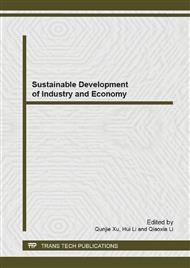[1]
Ministry of Transport of the People's Republic of China. Traffic Transportation Twelfth Five-Year, Development Planning[R]. Beijing, (2011).
Google Scholar
[2]
Chengcheng Hou, The Research of Highway Carbon Emission and Expressway Carbon Sink under the Background of Global Climate Warming[D], China: Ocean University of China, (2013).
Google Scholar
[3]
JIAO Shuangjian, HOU Chengcheng, LI Yanwei , et al. Establishing the CO2 emission model of carbon neutral road based on gradient[C]. 2011 International Conference on Electrical and Control Engineering (ICECE), 2011, Vol. 5: 4494-4497.
DOI: 10.1109/iceceng.2011.6058422
Google Scholar
[4]
Xiaohui Liao, The Study of Multi-objective Intelligent Optimization in Highway Profile[D], China: Nanjing Forestry University, (2012).
Google Scholar
[5]
QIN Xiaochun, SHEN Yi, SHAO Shegang. the Key Technologies of the Green Highway Construction and Application of Low-carbon Concept[J]. Journal of Highway and Transportation Research and Development, 2010(7): 308-322.
DOI: 10.1109/mace.2011.5987760
Google Scholar
[6]
SHI Yourong, ZHAO Wei. Researchon Energy Conservation and Emission Reduction Integrated Management System of Highway and Waterway Transportation[J]. Journal of Wuhan University of Technology, 2010, 32(4): 31-37.
Google Scholar
[7]
Shaodong Guo, Rui Yang , Hui Zhang. Source identification for unsteady atmospheric dispersion of hazardous materials using Markov Chain Monte Carlo method[J]. International Journal of Heat and Mass Transfer. 2009, 52(17-18) : 3955-3962.
DOI: 10.1016/j.ijheatmasstransfer.2009.03.028
Google Scholar
[8]
Eugene Yee, Fue-Sang Lien , Andrew Keats. Bayesian inversion of concentration data: Source reconstruction in the adjoint representation of atmospheric diffusion[J]. Journal of wind engineering and industrial aerodynamics, 2008, 96(10-11): 1805-1816.
DOI: 10.1016/j.jweia.2008.02.024
Google Scholar
[9]
Yu Fu, Setting the Chinese Carbon Emission Trading Market[D], China: Nanjing Forestry University, (2007).
Google Scholar
[10]
Xin Wang, Research on the Influence Mechanism of China's Carbon Trade Price[D], China: China University of Geosciences, (2011).
Google Scholar
[11]
Technical Code for Maintenance of Highway, JTJ 073-1996[S].
Google Scholar
[12]
Longsheng Bao, Ling Yu, Lanyu Zhou, Establishment and application of pavement maintenance cost mode[J]. Journal of Shen yang Arch. and Civ. Eng. Inst. 2000, Vol. 16, No. 1, 10-13.
Google Scholar


